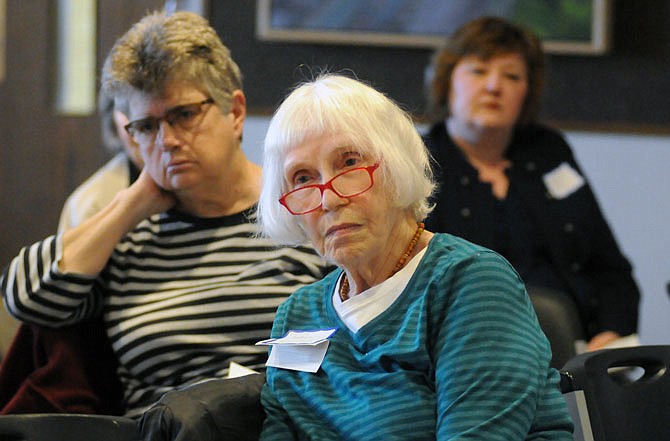The Jefferson City Homelessness Task force held an informational meeting Thursday, allowing people to learn about coordinated entry.
Housing and Urban Development required that coordinated entry be implemented by Jan. 23 this year, said Kelli Watkins-Turley, the Jefferson City-area lead for the program.
Coordinated entry is a process developed by HUD to ensure all people experiencing a housing crisis have fair and equal access to housing, according to the agency's website. HUD also requires that people experiencing housing issues are quickly identified, assessed for, referred to, and connected to housing and assistance based on their needs.
For example, if a transient, homeless person arrives in a community like Jefferson City, he wouldn't know what resources are available to him, Watkins-Turley said.
"They're going to have to be experts on the resources in Jefferson City to know where all the housing programs are," she said, "and know how to get into all the programs, and know what paperwork they're going to need."
It's extremely complex and did not work well for people who didn't know how to find the resources, she told more than 20 task force participants gathered Thursday at the Missouri River Regional Library. The task force - started in fall 2014 - looks at ways the city can provide education, resources and shelter options for homelessness. It is made up of churches, social work agencies and volunteers.
With implementation of coordinated entry, a homeless person can go to The Salvation Army, the Department of Mental Health or Common Ground and fill out one application that will refer them to all housing resources in the area. Common Ground is a community service agency whose mission is to provide innovative approaches to addressing needs of people in poverty.
More agencies and organizations potentially could offer the assessment, but there is a training component to assure all who offer it do it the same way.
The assessments help potential clients receive the correct "interventions," Watkins-Turley said. With a comprehensive, community-wide list, service providers can see which people need their services the most, she said.
"We're really able to truly assess what people really need and how much support they need," Watkins-Turley said. "And to put them in a program that is appropriate for what they need."
The list also helps prevent agencies from duplicating services. There had been a great deal of overlap in the clients agencies served, she said.
Agencies and programs HUD said must participate in central Missouri are the Department of Mental Health, Phoenix Health Programs (for recovery), The Salvation Army, Columbia Housing Authority, Rainbow House (children's emergency shelter and advocacy center), True North (shelter for victims of domestic violence), Voluntary Action Center (services to low-income families) and Welcome Home (services for homeless veterans). Other partners, like Common Ground, participate without being mandated.
After Watkins-Turley listed the agencies and organizations involved, a listener commented that most organizations involved were "north of the river."
"That's where a significant portion of the homeless population is in this area," she replied. "So they get a lot more resources than we do in Jefferson City."
There are multiple ways people may be considered for coordinated entry, she said.
Anyone having a housing crisis can be referred into the program. But anyone to be considered for housing through the program has to meet HUD's definition of homelessness.
Broadly speaking, they are people living in emergency shelters or living on the street. They may also be in transitional housing.
The assessment, called the Vulnerability Index - Service Prioritization Decision Assistance Tool (VI-SPDAT 2.0) - looks at all the factors affecting homelessness such as length of time a person has been homeless, physical health, mental health, substance use, police interactions and family composition.
"Really, what it's looking for is 'How vulnerable is this person?'" Watkins-Turley said.
Shawn Burch, a veterans representative at the Missouri Career Center in Jefferson City, said giving people hope would help end homelessness.
Many people fall into and out of homelessness, Common Ground Director Kristen Hilty said. But the chronically homeless are most likely to show up on the coordinated entry list, Hilty said.
Many of them may not choose to take the assessment and be on the list, she said.
"They are the most vulnerable, in my mind, are the ones I have trouble convincing to get on the list," Hilty said.
If they are on the list, they would most likely be first selected to receive services, she said.
Claudia Cook, the library director, said her facility is often the first place of contact transient homeless people find when arriving in Jefferson City.
"We've long wanted some social services here in the library," she said. "All the staff here (already) have sensitivity training."
The library already provides resources homeless people need, such as internet access. Libraries all over the United States are helping homeless people, she said. They held a nationwide webinar over the past week all her staff were required to watch to learn how best to help people in a public platform.
"You're kind of on the front line for that," Hilty said. "You're the first responders on homeless issues."

